radio TOYOTA AVENSIS 2017 Owners Manual (in English)
[x] Cancel search | Manufacturer: TOYOTA, Model Year: 2017, Model line: AVENSIS, Model: TOYOTA AVENSIS 2017Pages: 661, PDF Size: 39.92 MB
Page 4 of 661
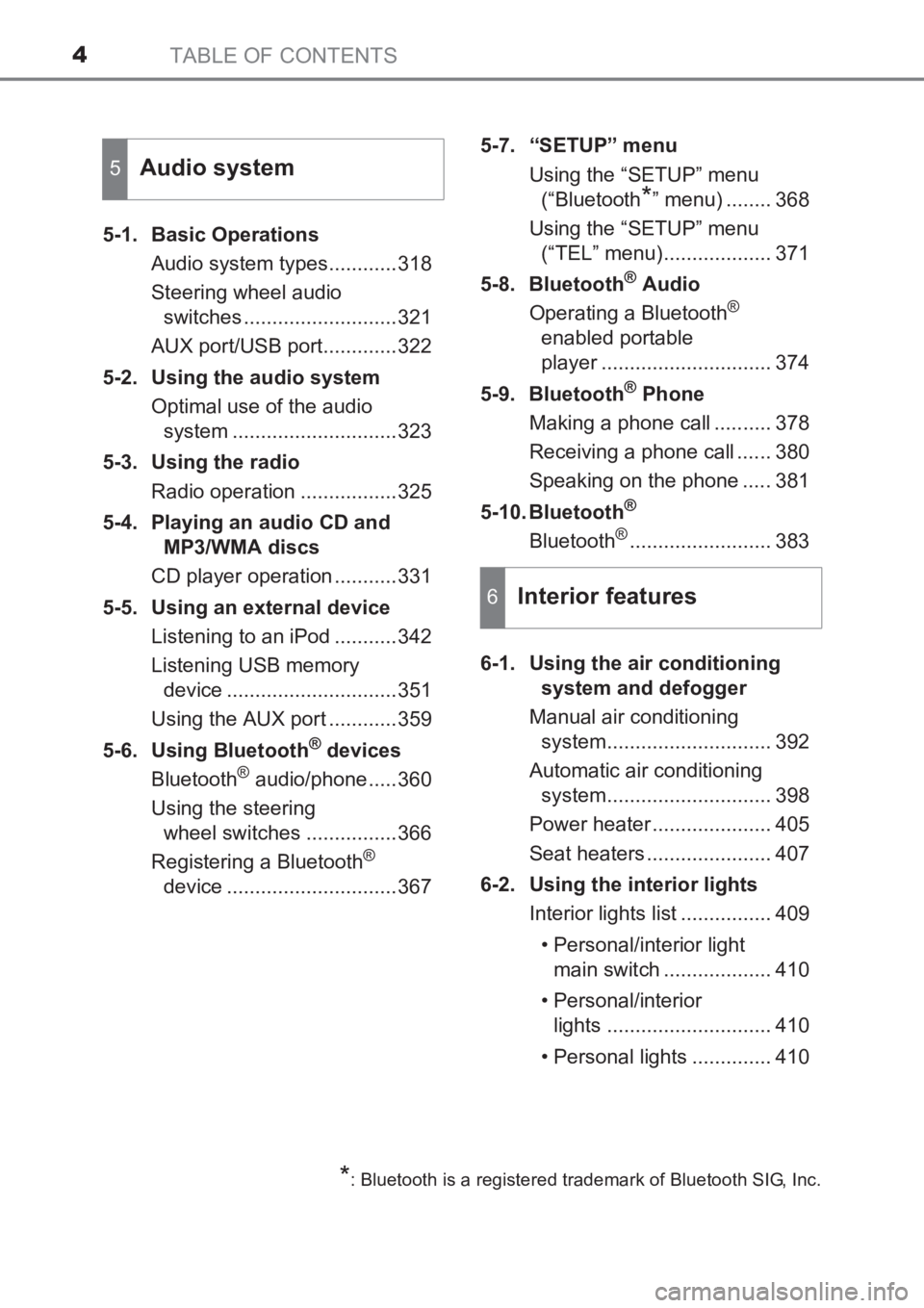
TABLE OF CONTENTS4
AVENSIS_OM_OM20C66E_(EE)5-1. Basic Operations
Audio system types............318
Steering wheel audio switches ...........................321
AUX port/USB port.............322
5-2. Using the audio system Optimal use of the audio system .............................323
5-3. Using the radio Radio operation .................325
5-4. Playing an audio CD and MP3/WMA discs
CD player operation ...........331
5-5. Using an external device Listening to an iPod ...........342
Listening USB memory device ..............................351
Using the AUX port ............359
5-6. Using Bluetooth
® devices
Bluetooth® audio/phone .....360
Using the steering wheel switches ................366
Registering a Bluetooth
®
device ..............................367 5-7. “SETUP” menu
Using the “SETUP” menu(“Bluetooth
*” menu) ........ 368
Using the “SETUP” menu (“TEL” menu)................... 371
5-8. Bluetooth
® Audio
Operating a Bluetooth®
enabled portable
player .............................. 374
5-9. Bluetooth
® Phone
Making a phone call .......... 378
Receiving a phone call ...... 380
Speaking on the phone ..... 381
5-10. Bluetooth
®
Bluetooth®......................... 383
6-1. Using the air conditioning system and defogger
Manual air conditioning system............................. 392
Automatic air conditioning system............................. 398
Power heater ..................... 405
Seat heaters ...................... 407
6-2. Using the interior lights Interior lights list ................ 409
• Personal/interior light main switch ................... 410
• Personal/interior lights ............................. 410
• Personal lights .............. 410
5Audio system
*: Bluetooth is a registered trademark of Bluetooth SIG, Inc.
6Interior features
AVENSIS_OM_OM20C66E_(EE).book Page 4 Wednesday, June 15, 2016 4:07 PM
Page 45 of 661
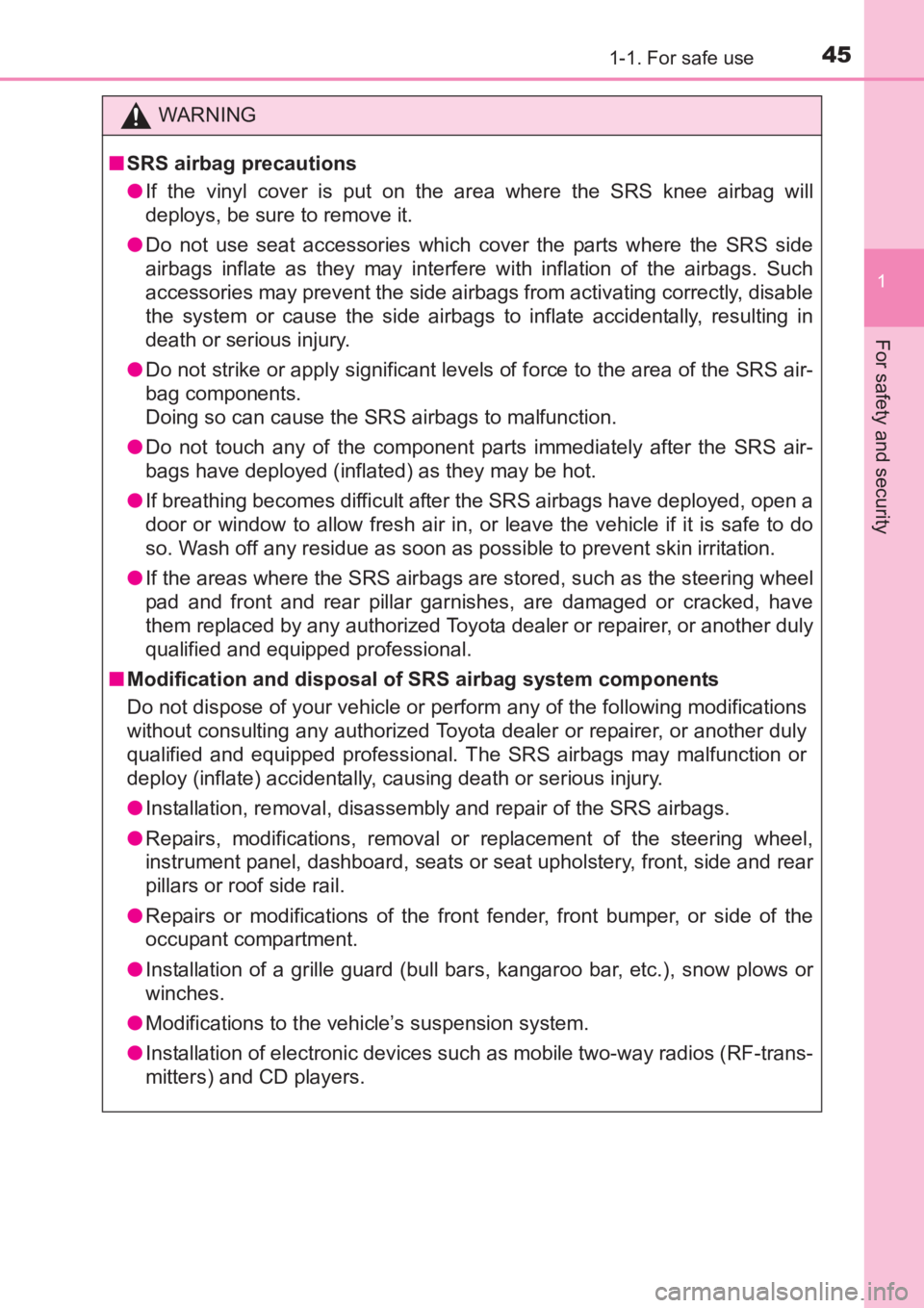
451-1. For safe use
1
AVENSIS_OM_OM20C66E_(EE)
For safety and security
WARNING
■ SRS airbag precautions
●If the vinyl cover is put on the area where the SRS knee airbag will
deploys, be sure to remove it.
● Do not use seat accessories which cover the parts where the SRS side
airbags inflate as they may interfere with inflation of the airbags. Such
accessories may prevent the side airbags from activating correctly, disable
the system or cause the side airbags to inflate accidentally, resulting in
death or serious injury.
● Do not strike or apply significant levels of force to the area of the SRS air-
bag components.
Doing so can cause the SRS airbags to malfunction.
● Do not touch any of the component parts immediately after the SRS air-
bags have deployed (inflated) as they may be hot.
● If breathing becomes difficult after the SRS airbags have deployed, open a
door or window to allow fresh air in, or leave the vehicle if it is safe to do
so. Wash off any residue as soon as possible to prevent skin irritation.
● If the areas where the SRS airbags ar e stored, such as the steering wheel
pad and front and rear pillar garni shes, are damaged or cracked, have
them replaced by any authorized Toyota dealer or repairer, or another duly
qualified and equipped professional.
■ Modification and disposal of SRS airbag system components
Do not dispose of your vehicle or perform any of the following modifications
without consulting any authorized Toyota dealer or repairer, or another duly
qualified and equipped professional. The SRS airbags may malfunction or
deploy (inflate) accidentally, causing death or serious injury.
●Installation, removal, disassembly and repair of the SRS airbags.
● Repairs, modifications, removal or replacement of the steering wheel,
instrument panel, dashboard, seats or seat upholstery, front, side and rear
pillars or roof side rail.
● Repairs or modifications of the front fender, front bumper, or side of the
occupant compartment.
● Installation of a grille guard (bull bar s, kangaroo bar, etc.), snow plows or
winches.
● Modifications to the vehicle’s suspension system.
● Installation of electronic devices such as mobile two-way radios (RF-trans-
mitters) and CD players.
AVENSIS_OM_OM20C66E_(EE).book Page 45 Wednesday, June 15, 201 6 4:07 PM
Page 123 of 661
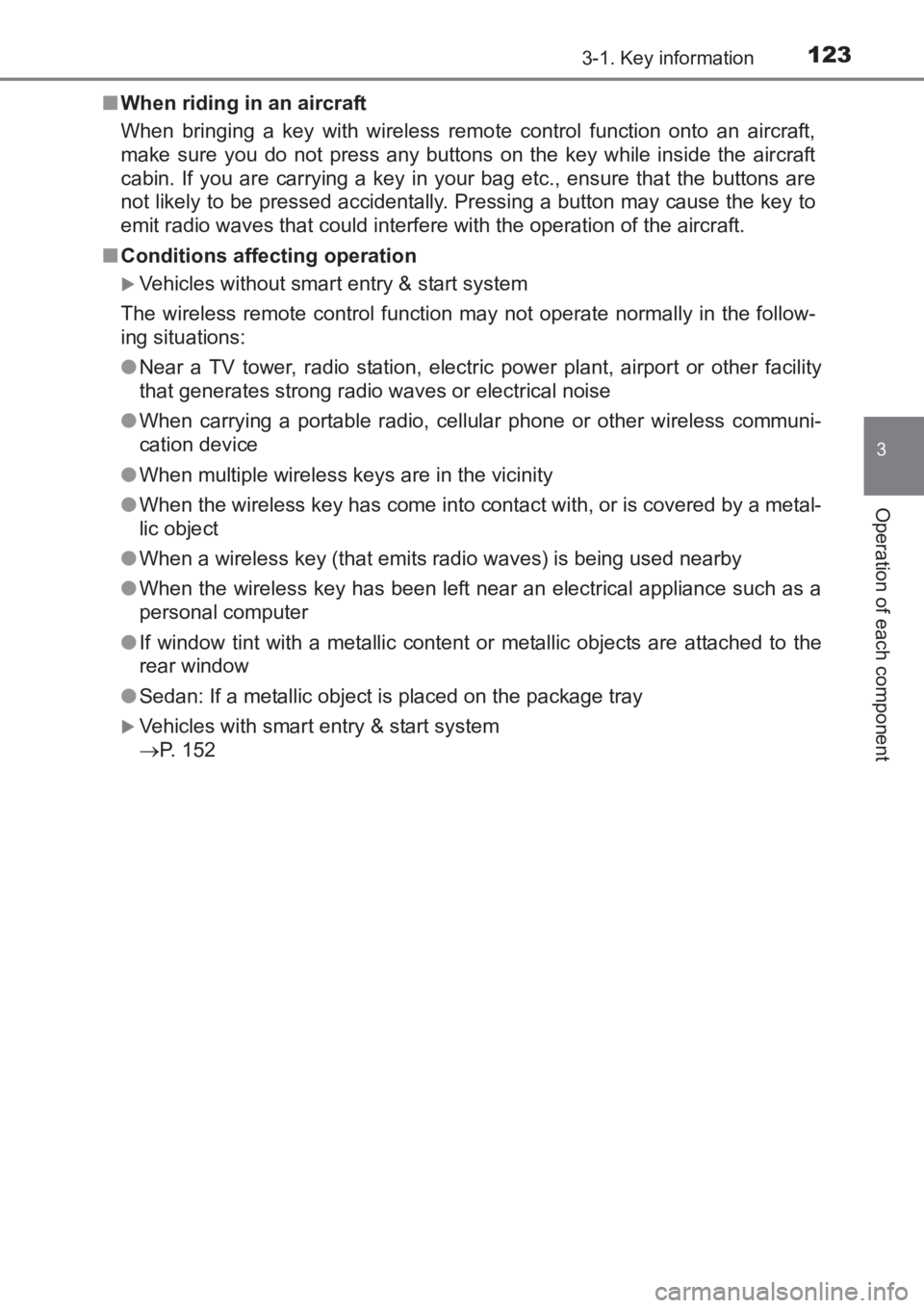
1233-1. Key information
3
Operation of each component
AVENSIS_OM_OM20C66E_(EE)■
When riding in an aircraft
When bringing a key with wireless remo te control function onto an aircraft,
make sure you do not press any buttons on the key while inside the aircraft
cabin. If you are carrying a key in your bag etc., ensure that the buttons are
not likely to be pressed accidentally. Pressing a button may cause the key to
emit radio waves that could interfere with the operation of the aircraft.
■ Conditions affecting operation
�XVehicles without smart entry & start system
The wireless remote control function may not operate normally in the follow-
ing situations:
● Near a TV tower, radio station, electr ic power plant, airport or other facility
that generates strong radio waves or electrical noise
● When carrying a portable radio, cellular phone or other wireless communi-
cation device
● When multiple wireless keys are in the vicinity
● When the wireless key has come into contact with, or is covered by a metal-
lic object
● When a wireless key (that emits radio waves) is being used nearby
● When the wireless key has been left near an electrical appliance such as a
personal computer
● If window tint with a metallic content or metallic objects are attached to the
rear window
● Sedan: If a metallic object is placed on the package tray
�XVehicles with smart entry & start system
→ P. 152
AVENSIS_OM_OM20C66E_(EE).book Page 123 Wednesday, June 15, 20 16 4:07 PM
Page 131 of 661
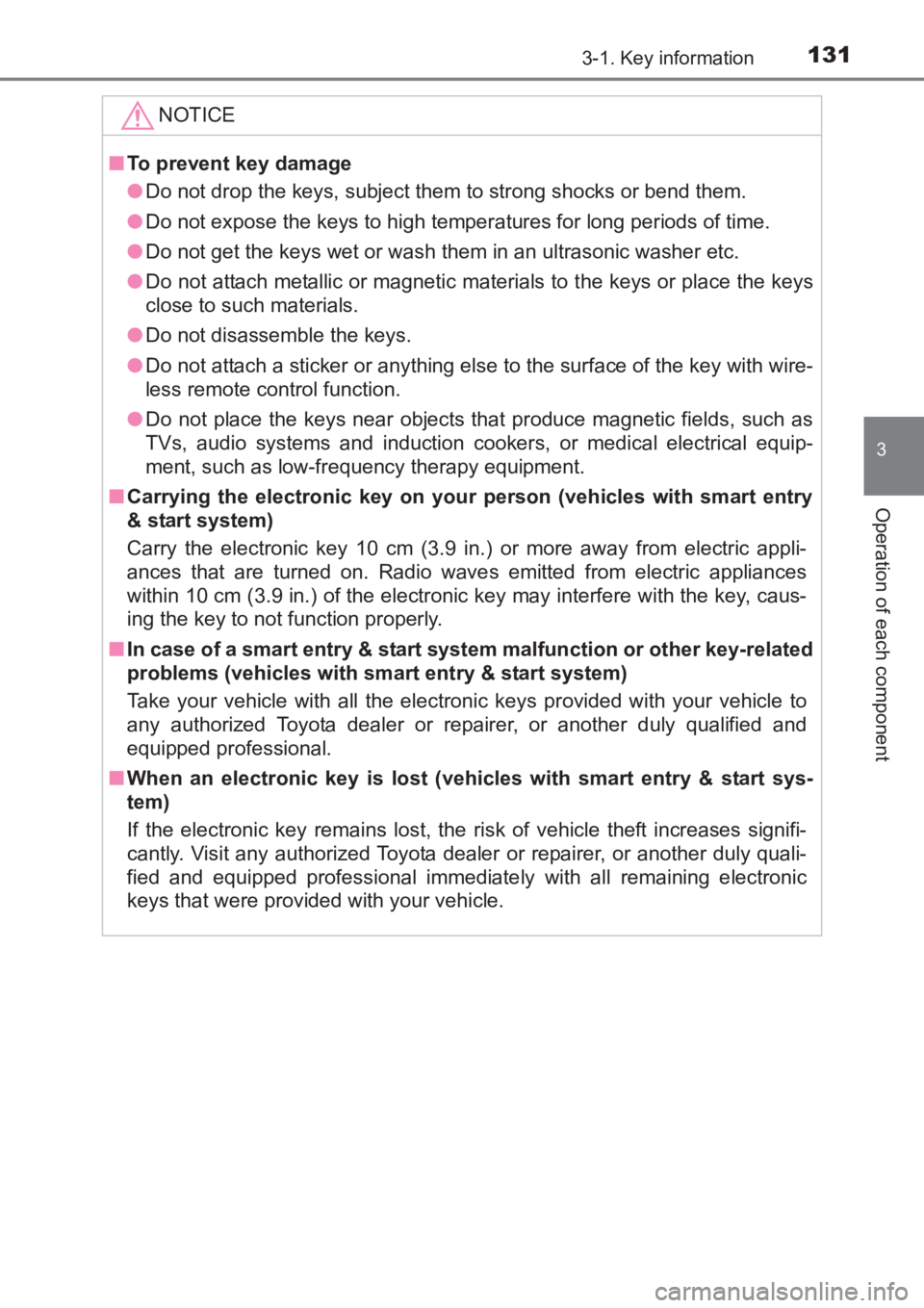
1313-1. Key information
3
Operation of each component
AVENSIS_OM_OM20C66E_(EE)NOTICE
■
To prevent key damage
●Do not drop the keys, subject them to strong shocks or bend them.
● Do not expose the keys to high temperatures for long periods of time.
● Do not get the keys wet or wash them in an ultrasonic washer etc.
● Do not attach metallic or magnetic materials to the keys or place the keys
close to such materials.
● Do not disassemble the keys.
● Do not attach a sticker or anything else to the surface of the key with wire-
less remote control function.
● Do not place the keys near objects that produce magnetic fields, such as
TVs, audio systems and induction cookers, or medical electrical equip-
ment, such as low-frequency therapy equipment.
■ Carrying the electronic key on your person (vehicles with smart entry
& start system)
Carry the electronic key 10 cm (3.9 in.) or more away from electric appli-
ances that are turned on. Radio wave s emitted from electric appliances
within 10 cm (3.9 in.) of the electronic key may interfere with the key, caus-
ing the key to not function properly.
■ In case of a smart entry & start syst em malfunction or other key-related
problems (vehicles with smart entry & start system)
Take your vehicle with all the electronic keys provided with your vehicle to
any authorized Toyota dealer or repairer, or another duly qualified and
equipped professional.
■ When an electronic key is lost (vehicles with smart entry & start sys-
tem)
If the electronic key remains lost, the risk of vehicle theft increases signifi-
cantly. Visit any authorized Toyota dealer or repairer, or another duly quali-
fied and equipped professional immediately with all remaining electronic
keys that were provided with your vehicle.
AVENSIS_OM_OM20C66E_(EE).book Page 131 Wednesday, June 15, 20 16 4:07 PM
Page 152 of 661
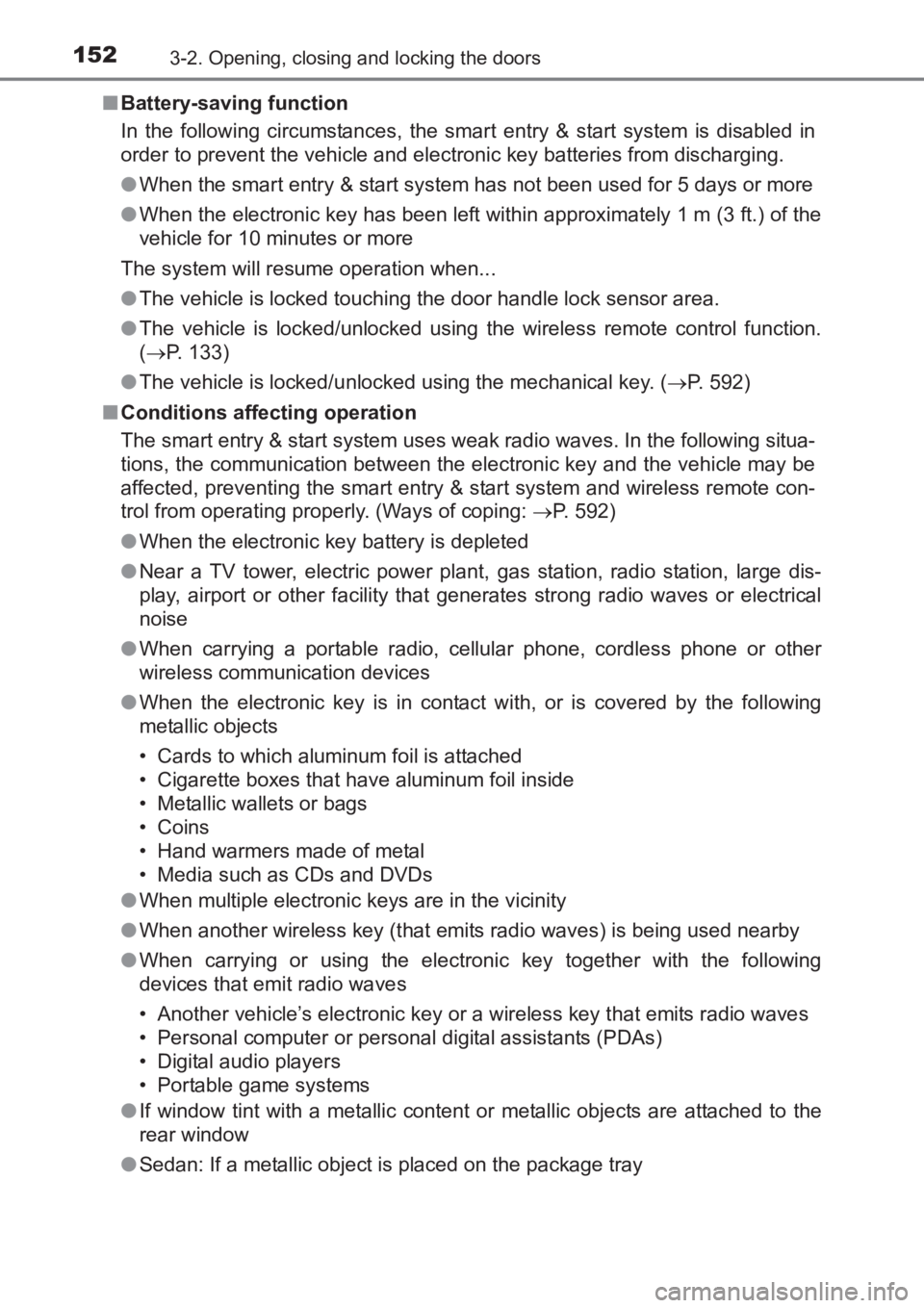
1523-2. Opening, closing and locking the doors
AVENSIS_OM_OM20C66E_(EE)■
Battery-saving function
In the following circumstances, the smart entry & start system is disabled in
order to prevent the vehicle and elec tronic key batteries from discharging.
● When the smart entry & start system has not been used for 5 days or more
● When the electronic key has been left within approximately 1 m (3 ft.) of the
vehicle for 10 minutes or more
The system will resume operation when...
● The vehicle is locked touching the door handle lock sensor area.
● The vehicle is locked/unlocked using the wireless remote control function.
(→ P. 133)
● The vehicle is locked/unlocked using the mechanical key. ( →P. 592)
■ Conditions affecting operation
The smart entry & start system uses weak radio waves. In the following situa-
tions, the communication between the electronic key and the vehicle may be
affected, preventing the smart entry & start system and wireless remote con-
trol from operating proper ly. (Ways of coping: →P. 592)
● When the electronic key battery is depleted
● Near a TV tower, electric power plant, gas station, radio station, large dis-
play, airport or other facility that generates strong radio waves or electrical
noise
● When carrying a portable radio, cellular phone, cordless phone or other
wireless communication devices
● When the electronic key is in contact with, or is covered by the following
metallic objects
• Cards to which aluminum foil is attached
• Cigarette boxes that have aluminum foil inside
• Metallic wallets or bags
• Coins
• Hand warmers made of metal
• Media such as CDs and DVDs
● When multiple electronic keys are in the vicinity
● When another wireless key (that emits radio waves) is being used nearby
● When carrying or using the electronic key together with the following
devices that emit radio waves
• Another vehicle’s electronic key or a wireless key that emits radio waves
• Personal computer or personal digital assistants (PDAs)
• Digital audio players
• Portable game systems
● If window tint with a metallic content or metallic objects are attached to the
rear window
● Sedan: If a metallic object is placed on the package tray
AVENSIS_OM_OM20C66E_(EE).book Page 152 Wednesday, June 15, 20 16 4:07 PM
Page 153 of 661
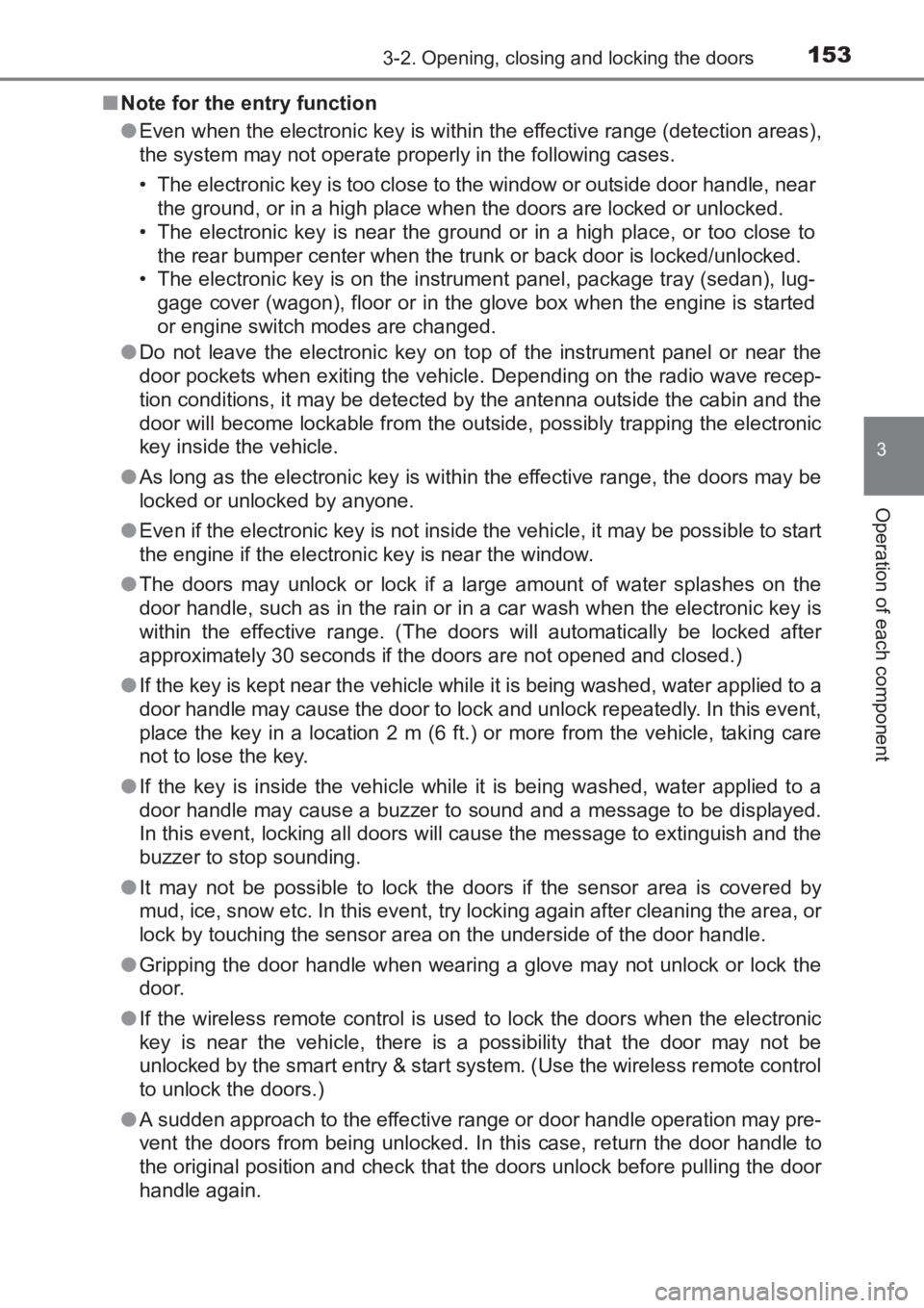
1533-2. Opening, closing and locking the doors
3
Operation of each component
AVENSIS_OM_OM20C66E_(EE)■
Note for the entry function
●Even when the electronic key is within the effective range (detection areas),
the system may not operate properly in the following cases.
• The electronic key is too close to the window or outside door handle, near
the ground, or in a high place w hen the doors are locked or unlocked.
• The electronic key is near the ground or in a high place, or too close to the rear bumper center when the tr unk or back door is locked/unlocked.
• The electronic key is on the instrument panel, package tray (sedan), lug-
gage cover (wagon), floor or in the glove box when the engine is started
or engine switch modes are changed.
● Do not leave the electronic key on top of the instrument panel or near the
door pockets when exiting the vehicle. Depending on the radio wave recep-
tion conditions, it may be detected by the antenna outside the cabin and the
door will become lockable from the outside, possibly trapping the electronic
key inside the vehicle.
● As long as the electronic key is within the effective range, the doors may be
locked or unlocked by anyone.
● Even if the electronic key is not inside the vehicle, it may be possible to start
the engine if the electronic key is near the window.
● The doors may unlock or lock if a large amount of water splashes on the
door handle, such as in the rain or in a car wash when the electronic key is
within the effective range. (The doors will automatically be locked after
approximately 30 seconds if the doors are not opened and closed.)
● If the key is kept near the vehicle while it is being washed, water applied to a
door handle may cause the door to lock and unlock repeatedly. In this event,
place the key in a location 2 m (6 ft.) or more from the vehicle, taking care
not to lose the key.
● If the key is inside the vehicle while it is being washed, water applied to a
door handle may cause a buzzer to sound and a message to be displayed.
In this event, locking all doors will cause the message to extinguish and the
buzzer to stop sounding.
● It may not be possible to lock the doors if the sensor area is covered by
mud, ice, snow etc. In this event, try locking again after cleaning the area, or
lock by touching the sensor area on the underside of the door handle.
● Gripping the door handle when wearing a glove may not unlock or lock the
door.
● If the wireless remote control is used to lock the doors when the electronic
key is near the vehicle, there is a possibility that the door may not be
unlocked by the smart entry & start system. (Use the wireless remote control
to unlock the doors.)
● A sudden approach to the effective ra nge or door handle operation may pre-
vent the doors from being unlocked. In this case, return the door handle to
the original position and check that the doors unlock before pulling the door
handle again.
AVENSIS_OM_OM20C66E_(EE).book Page 153 Wednesday, June 15, 20 16 4:07 PM
Page 165 of 661
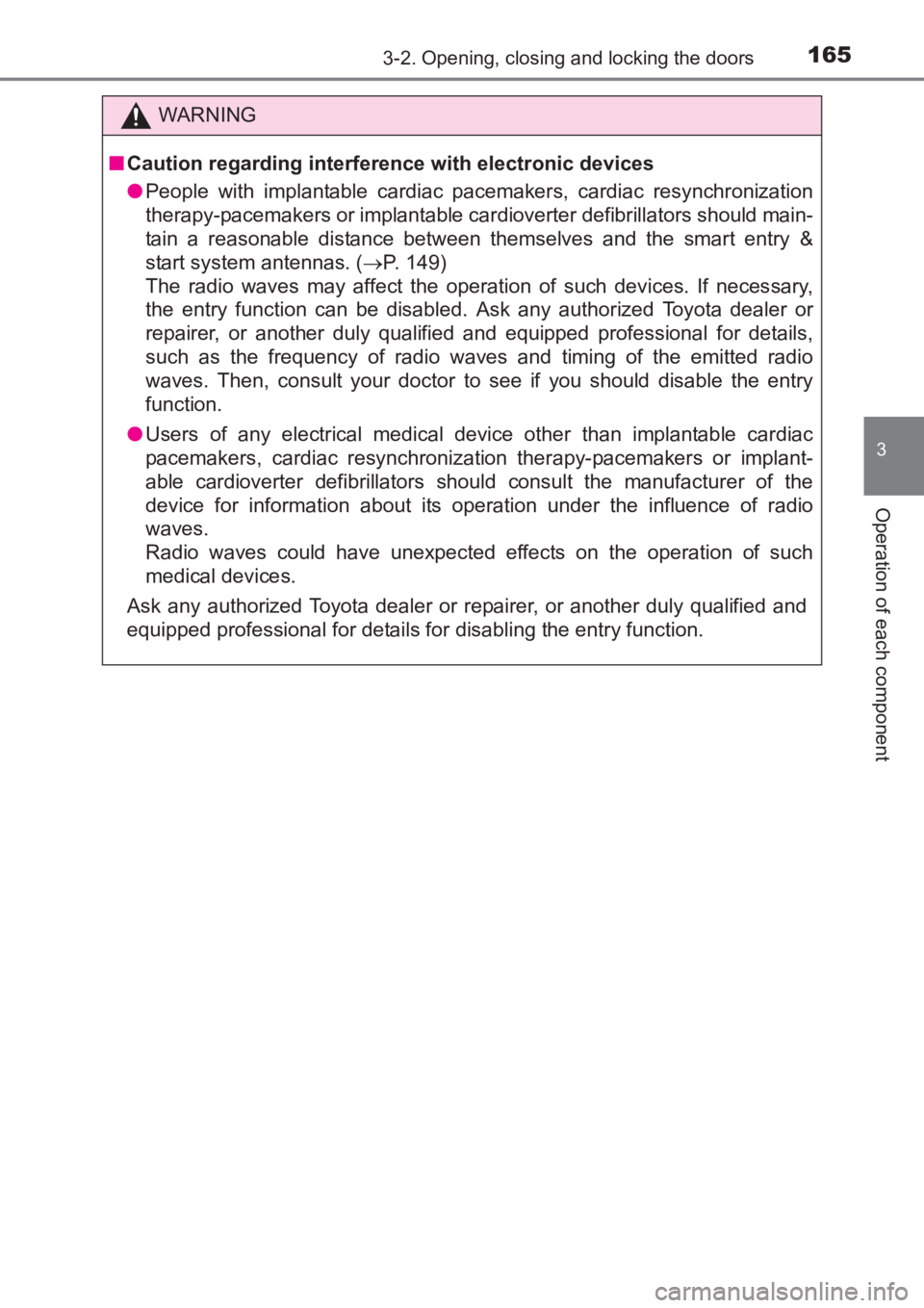
1653-2. Opening, closing and locking the doors
3
Operation of each component
AVENSIS_OM_OM20C66E_(EE)
WARNING
■ Caution regarding interference with electronic devices
●People with implantable cardiac pacemakers, cardiac resynchronization
therapy-pacemakers or implantable cardioverter defibrillators should main-
tain a reasonable distance between themselves and the smart entry &
start system antennas. ( →P. 149)
The radio waves may affect the operation of such devices. If necessary,
the entry function can be disabled. Ask any authorized Toyota dealer or
repairer, or another duly qualified and equipped professional for details,
such as the frequency of radio waves and timing of the emitted radio
waves. Then, consult your doctor to see if you should disable the entry
function.
● Users of any electrical medical device other than implantable cardiac
pacemakers, cardiac resynchronization therapy-pacemakers or implant-
able cardioverter defibrillators should consult the manufacturer of the
device for information about its operation under the influence of radio
waves.
Radio waves could have unexpected effects on the operation of such
medical devices.
Ask any authorized Toyota dealer or repairer, or another duly qualified and
equipped professional for details for disabling the entry function.
AVENSIS_OM_OM20C66E_(EE).book Page 165 Wednesday, June 15, 20 16 4:07 PM
Page 317 of 661
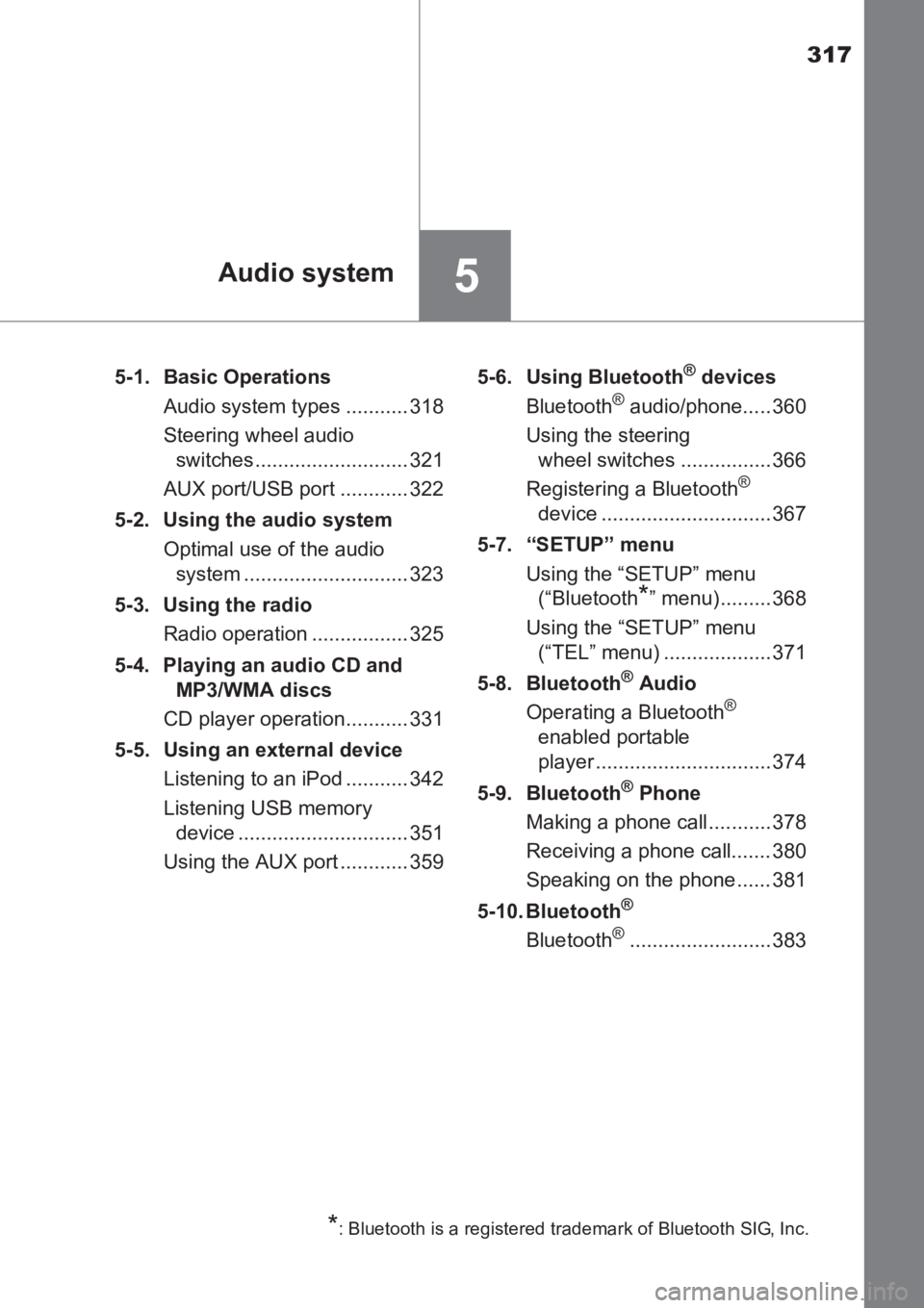
317
5Audio system
AVENSIS_OM_OM20C66E_(EE)5-1. Basic Operations
Audio system types ........... 318
Steering wheel audio switches ........................... 321
AUX port/USB port ............ 322
5-2. Using the audio system Optimal use of the audio system ............................. 323
5-3. Using the radio Radio operation ................. 325
5-4. Playing an audio CD and MP3/WMA discs
CD player operation........... 331
5-5. Using an external device Listening to an iPod ........... 342
Listening USB memory device .............................. 351
Using the AUX port ............ 359 5-6. Using Bluetooth
® devices
Bluetooth® audio/phone..... 360
Using the steering wheel switches ................366
Registering a Bluetooth
®
device .............................. 367
5-7. “SETUP” menu Using the “SETUP” menu(“Bluetooth
*” menu)......... 368
Using the “SETUP” menu (“TEL” menu) ................... 371
5-8. Bluetooth
® Audio
Operating a Bluetooth®
enabled portable
player ............................... 374
5-9. Bluetooth
® Phone
Making a phone call ........... 378
Receiving a phone call....... 380
Speaking on the phone ...... 381
5-10. Bluetooth
®
Bluetooth®......................... 383
*: Bluetooth is a registered trademark of Bluetooth SIG, Inc.
AVENSIS_OM_OM20C66E_(EE).book Page 317 Wednesday, June 15, 20 16 4:07 PM
Page 318 of 661
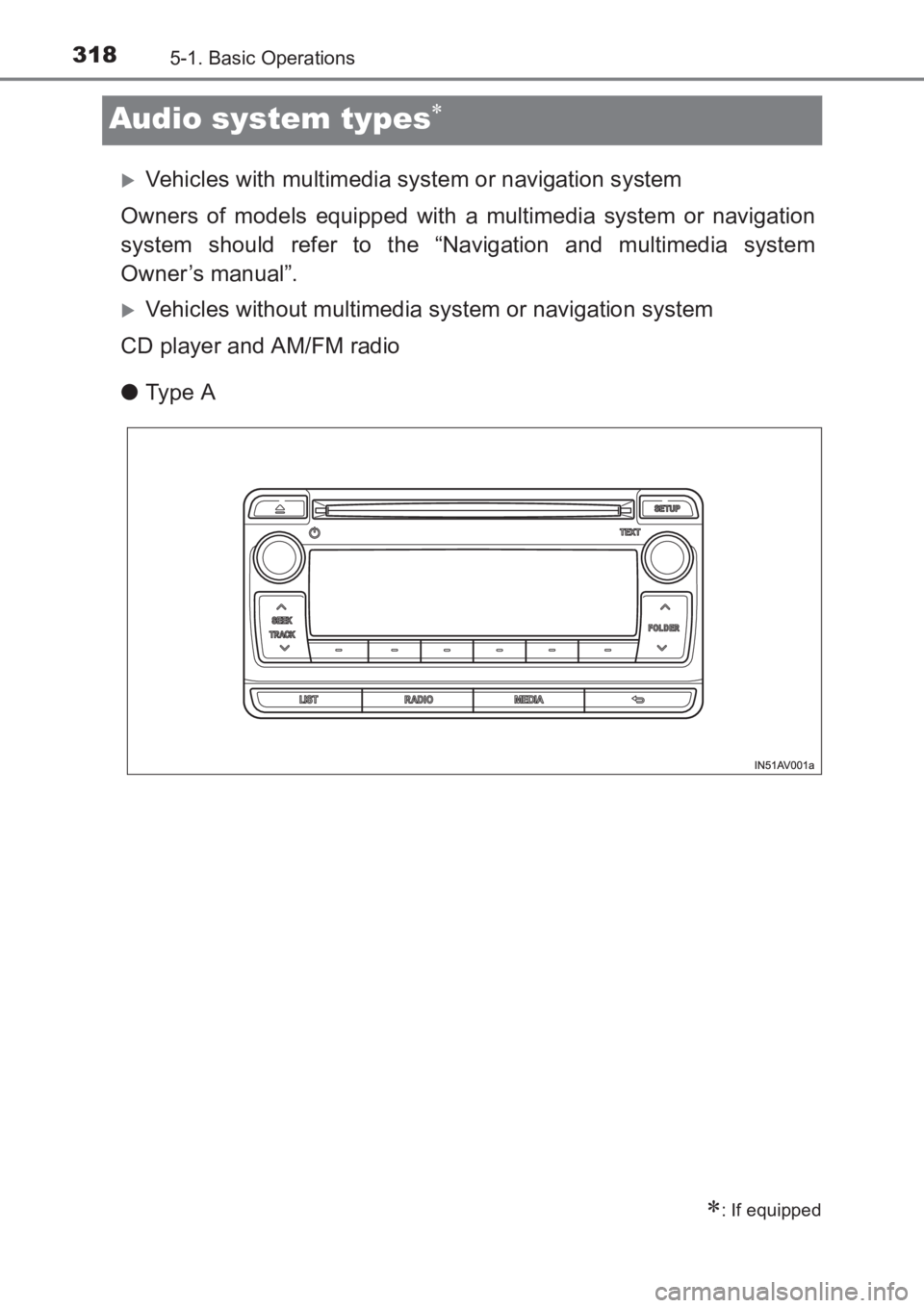
3185-1. Basic Operations
AVENSIS_OM_OM20C66E_(EE)
Audio system types∗
�XVehicles with multimedia system or navigation system
Owners of models equipped with a multimedia system or navigation
system should refer to the “Navigation and multimedia system
Owner’s manual”.
�XVehicles without multimedia system or navigation system
CD player and AM/FM radio
● Ty pe A
∗: If equipped
AVENSIS_OM_OM20C66E_(EE).book Page 318 Wednesday, June 15, 20 16 4:07 PM
Page 321 of 661
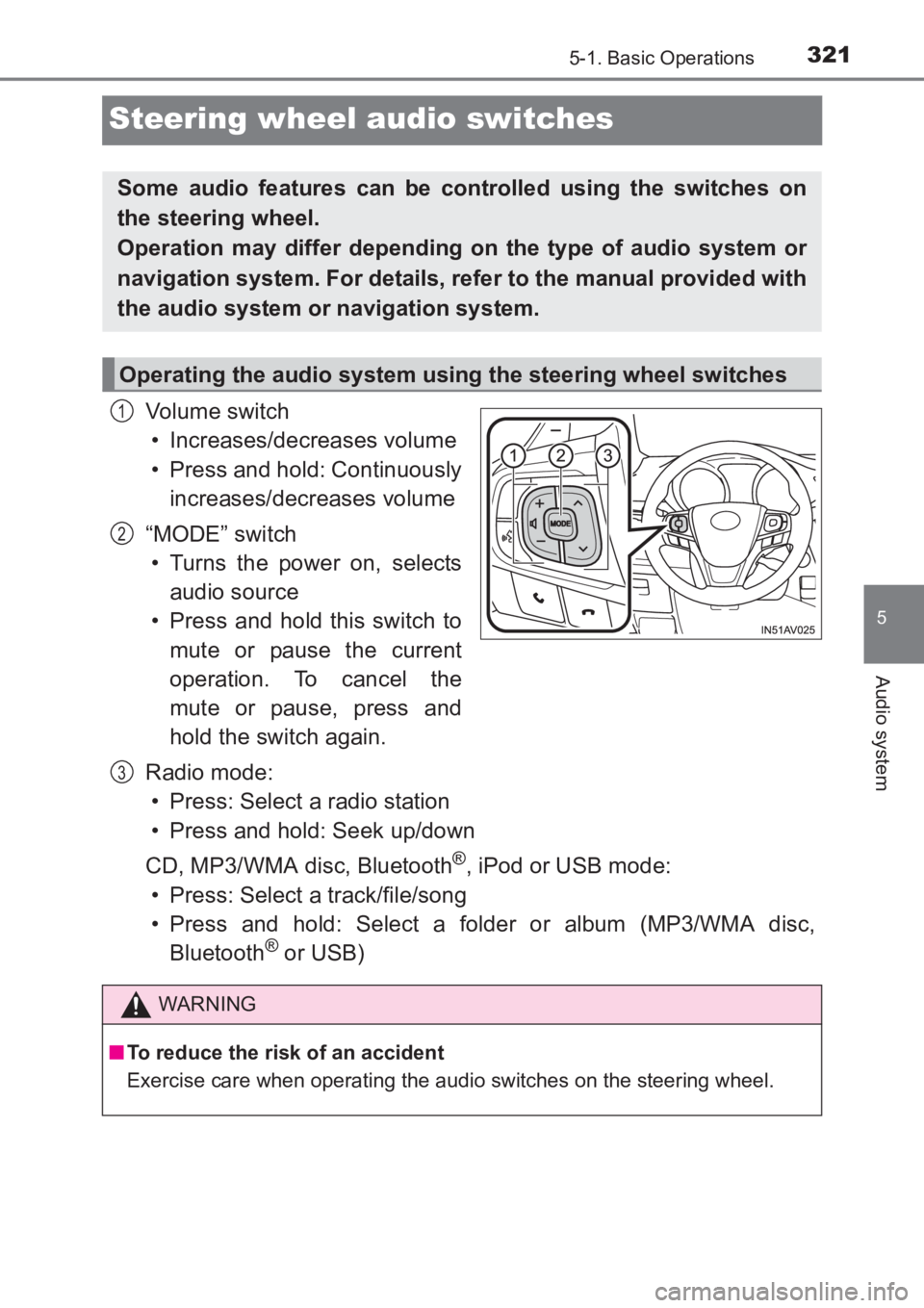
321
5
5-1. Basic Operations
Audio system
AVENSIS_OM_OM20C66E_(EE)
Steering wheel audio switches
Vo lu m e swi tc h• Increases/decreases volume
• Press and hold: Continuously increases/decreases volume
“MODE” switch • Turns the power on, selects
audio source
• Press and hold this switch to
mute or pause the current
operation. To cancel the
mute or pause, press and
hold the switch again.
Radio mode: • Press: Select a radio station
• Press and hold: Seek up/down
CD, MP3/WMA disc, Bluetooth
®, iPod or USB mode:
• Press: Select a track/file/song
• Press and hold: Select a folder or album (MP3/WMA disc, Bluetooth
® or USB)
Some audio features can be controlled using the switches on
the steering wheel.
Operation may differ depending on the type of audio system or
navigation system. For details, refer to the manual provided with
the audio system or navigation system.
Operating the audio system using the steering wheel switches
1
2
WARNING
■ To reduce the risk of an accident
Exercise care when operating the audio switches on the steering wheel.
3
AVENSIS_OM_OM20C66E_(EE).book Page 321 Wednesday, June 15, 20 16 4:07 PM